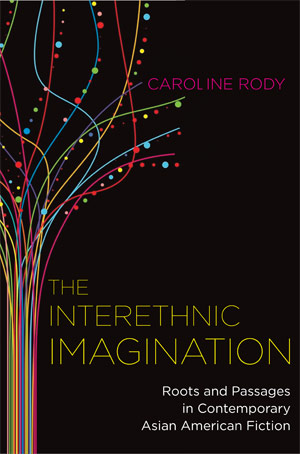
The Interethnic Imagination raises to view an important shift in the contemporary literature Americans have been reading. It claims that since the last quarter of the twentieth century, in the wake of all that’s changing in local and global cultures, in patterns of migration, communication, and interaction among peoples from all parts of the world, ethnic American literature is becoming interethnic literature. That is to say, literatures deeply rooted in one or another people’s histories and traditions show a growing urge to encounter the lives of others, to enter and explore the dynamic arena of the American multiculture.
Asian American fiction—a booming, enormously inventive body of work—is at the center of this book, as case study and as avatar of the historic turn to the interethnic across the spectrum of ethnic American literatures.
In three main chapters, I focus on particularly rich 1990s novels: Chang-rae Lee’s dark rendering of a conflicted Korean American New York City spy, Native Speaker; Gish Jen’s hilarious treatment of growing up Chinese American in a Jewish New York suburb, Mona in the Promised Land; and Karen Tei Yamashita’s magical realist epic of mass migration from Asia and Latin America to Los Angeles, Tropic of Orange. These chapters closely read writers’ experimentation with literary characters, narrative voices, plots, structures, social visions, and cross-ethnic literary borrowing to tell new kinds of American stories.
Many other recent Asian American texts enter the discussion—some in shorter “interchapters” that take up special in-between topics in cross-ethnic literary encounter: African American presences in contemporary Asian American texts, the cross-ethnic writing of Jewishness, and the history of mixed-race Asian American literary characters.
“Several adult characters from these novels, by mastering and mixing multiple ethnic languages, kinds of music, cuisines, rituals, or forms of political speech, become spectacles of charged, riddling, potentially liberating multiethnic fusion.”
I was trained as an ethnic Americanist and wrote my first book on African American and Caribbean women’s fictions about history—mostly novels about slavery. You might think of that project as a kind that followed a “vertical” imaginative axis: the axis of one specific literary tradition (or in this case, two related traditions).
But as I researched that book, I was surprised to keep bumping up against a “horizontal” axis, in which writers imagined their historical heroines having significant encounters with women of other groups.
My best example is always Toni Morrison’s powerful Beloved, in which a pregnant, escaping slave woman who goes into labor in a Kentucky wood unexpectedly finds a midwife in a stray “whitegirl” also running north, away from servitude in a violent home. The fact that Morrison draws these two women as parallel as possible, given the imagined historical moment, that she plants secret, interethnic cooperation right there in the very womb of her own ethnic history—the last place one would expect to find it, and that the baby birthed by these two in the wilderness is named after the white midwife, alerted me to a deepening interethnic imbrication in American literature.
As I found such encounters multiplying across the historical fictions I read, my first book grew a counterplot of hybridity to complement its preoccupation with ancestry. And I found my next subject in the interethnic imagination of contemporary literature. I now want to extend to a general view of contemporary fiction the surprising twist that developed in my first book’s conception.
A good deal of ethnic literary critique still proceeds in distinct ethnic and racial areas. I have no interest in unseating the ethnic critical paradigm that traces distinct historical traditions, seeing every people’s literature as a crucial generator of stories to live by and a strategic identity marker for the marginalized. But I want to supplement this approach by offering the interethnic, a model that attends to the dialogism that arises where peoples and cultures meet.
Indeed, since I first began to track the phenomenon in the early 1990s, the hybridity of culture has become a more and more popular critical theme, in part through the influence of postcolonial, critical race, and globalization theories. But while cross-cultural and comparative studies have multiplied, the core of this book’s argument still needs to be articulated.
It is now broadly agreed that artists and writers, the ethnic groups and cultures from which they stem, and the cultural forms they produce, have always been intertwined. The Interethnic Imagination announces the emergence in our moment of a literature that presumes, that is founded on multiethnic interconnection, and it is this reality that I want to make apparent to readers and scholars.
I would hope that a browsing reader would open the book to its first pages—which I intended as a lively, reader-friendly introduction.
I start with a roster of surprising characters from contemporary Asian American fiction, unfamiliar kinds of characters who, because of their genetic mixture, or by means of their virtuso performances of cultural hybridity, embody contemporary fiction’s urge towards imaginative engagement with the difference of others.
The three novels given most extended attention in the book all close with scenes that feature a family embrace around a mixed-race child. Such children, positioned to leave the stamp of their faces on the books’ endings, look to me like a vision of the emerging American readership. I mean to point to them, too, as emblems of an increasingly open-ended American literature.
Several adult characters from these novels, by mastering and mixing multiple ethnic languages, kinds of music, cuisines, rituals, or forms of political speech become—for other characters and for the reader—spectacles of charged, riddling, potentially liberating multiethnic fusion.
Novelistic characters are not the only sites of the interethnic turn that this preface investigates, but I use them here as an introduction to the energetic invention a reader will find in the new interethnic literature.
The preface goes on to discuss the way that the English language itself in contemporary American fiction is dramatically swelling, crossbred with myriad immigrant languages that daily enrich it.
In Jiro Adachi’s The Island of Bicycle Dancers, a young Korean Japanese immigrant in lower Manhattan tries to pick up the local talk, but finds herself surrounded by “too many different kinds of English”: “Korean English” from her relatives, “American English” from a friend, “Chinese English from the high school kids on the 7 train, Spanish English everywhere, Russian English and Polish English near Lucky Market; black English all over, even from white people and some Asians—everyone trying to act black.”
Not simply the hegemonic language of a superpower, English here is a dynamic medium of cultural interchange, being reworked on the tongues of multitudes of its new possessors. The novels of the interethnic turn prefer their English different, mixed, new; they affirm linguistic multiplicity and fusion as in themselves good, finding uniform speech the enemy of vitality, beauty, and hope. They deliver a kind of English with its ears open to the talking world.
These unprecedented kinds of characters and the fresh language they bring to the American novel constitute just the first layer of the book’s investigations of a literature in transformation.
“The English language itself in contemporary American fiction is dramatically swelling, crossbred with myriad immigrant languages that daily enrich it.”
Besides calling readers’ and scholars’ attention to a paradigm shift in contemporary Asian American and other ethnic texts, I also hope this book will help spread appreciation for the imaginative work of contemporary fiction.
In the midst of enormous global changes, our writers are out there ahead of most thinkers, it seems to me, in imagining the consequences of the prodigious enmeshment of peoples happening all around us. They stretch the capacity of inherited literary forms (the novel, the short story) in remarkable ways to accommodate multiplicity and complexity of vision.
Not all of these stagings of encounter render up happiness, by any means. Fraught histories of racialization and intergroup relations haunt many of them, miring their plots of affiliation in uncertainty, foreboding, even grief. Lee’s Native Speaker, for example, oscillates between visions of the multicultural crowd as resplendent, global assemblage—in lyrical, Whitmanesque invocations of a colorful New York City sublime—and terrifying visions of the crowd as deadly force, one with potentially tragic consequences for the individual and for the home virtues of family, love, and loyalty.
But whether depicting dire or fruitful kinds of interethnic encounters, these texts move us with the seemingly limitless capacity of creative literature to reinterpret and to enrich our experience of the changing world.


Caroline Rody is Associate Professor of English at the University of Virginia. The Interethnic Imagination, featured in her Rorotoko interview, is her second book with Oxford University Press; the first was The Daughter’s Return: African-American and Caribbean Women’s Fictions of History (2001). She is currently at work on a study of the reimagination of the past in contemporary Jewish American fiction.